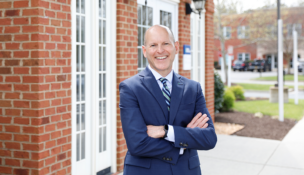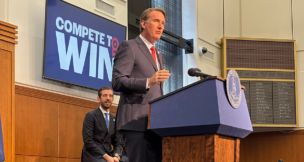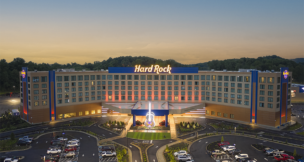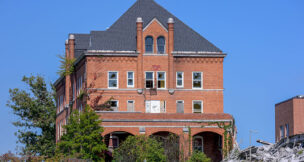Milestones: Virginia companies celebrating big anniversaries in 2025

Colonna’s Shipyard CEO Randall Crutchfield is the great-great grandson of the shipyard’s founder. Established in 1875, the privately held company turns 150 this year. Photo by Jay Paul

Colonna’s Shipyard CEO Randall Crutchfield is the great-great grandson of the shipyard’s founder. Established in 1875, the privately held company turns 150 this year. Photo by Jay Paul
Milestones: Virginia companies celebrating big anniversaries in 2025
Summary
- Virginia’s AI sector now valued at $1.71 billion amid global boom
- 10 Virginia companies celebrate 25 to 175 years in business
- Virginia Natural Gas marks 175 years of community service
- Colonna’s Shipyard and others show how tradition meets innovation
Even amid the AI revolution currently underway, there are viable signs of stability.
The global AI market could grow twenty-fivefold — from $189 billion in 2023 to $4.8 trillion — by 2033, according to a report this year from the United Nations. Containing the largest concentration of data centers in the world, Virginia, too, has been swept up in the artificial intelligence boom, with tech trade association the Chamber of Progress estimating the state’s AI sector is already worth $1.71 billion.
While predictions about AI’s transform-ative impact on business range from bold to scary, the full extent remains to be seen. But for all that could change, much will remain the same, if history is any guide.
Several prominent Virginia-based companies celebrating milestone anniversaries in 2025 demonstrate that while disruptive technologies will come and go, businesses that provide essential services and build loyal customers can thrive across decades and even centuries.
Through wars and recessions, shifts in politics and consumer preferences, these venerable businesses have found success by offering specialized services and becoming cornerstones of their communities. Here are the stories behind 10 Virginia companies celebrating milestone anniversaries this year, from 25 years to 175 years.

175 YEARS
VIRGINIA NATURAL GAS
Virginia Beach
By the mid-1800s, major changes were afoot in America — railroads and electric telegraphs made the nation feel more cohesive. And perhaps most noticeably, cities across the U.S. were increasingly transitioning to gas lighting. In 1850, the City of Norfolk joined the parade, granting a charter to City Gas Light Co. to illuminate its streets with gas lights.
That deal marked the beginning of Virginia Natural Gas (VNG), a utility serving 300,000-plus customers across southeastern Virginia. While the past 175 years have brought many, many changes, the company’s mission remains the same.
“Even if our words or our mottos may change and evolve over time, the core of who we are and what we do has remained constant — and that is to make sure we are delivering safe and reliable natural gas service to our customers,” says Shannon Pierce, who was named CEO of Virginia Natural Gas in April.
Today’s VNG has evolved out of numerous acquisitions and consolidations, and Pierce says a major company milestone is comparatively recent: In 2000, VNG was acquired by AGL Resources, which then became Southern Company Gas, part of Atlanta-based Southern Co., a gas and electric utility holding company.
“That was a pivotal part in VNG’s history because it allowed us to benefit from resources from a much bigger parent company and to share best practices and leverage those resources locally,” explains Pierce. VNG’s access to resources has grown “exponentially,” she adds, which benefits research and development, charitable giving efforts, and collaborations.

Such resources are valuable as VNG strives to serve growing energy demands. Earlier this year, it announced a partnership with the Hampton Roads Sanitation District to build a renewable natural gas facility at the Atlantic Treatment Plant, a sewage facility in Virginia Beach. Converting biogas from wastewater treatment into natural gas will provide an additional source of supply for customers, while honoring the company’s commitment to environmental stewardship and sustainability.
“That’s just an example of how we are continuing to make sure that we find innovative ways and use technology to meet the energy demands of the future,” Pierce says. Other recent efforts include modernizing 575-plus miles of pipeline and cutting emissions by 35% since 2012, she adds.
Looking ahead, VNG’s “safety-first” value remains crucial, both for its 1,000-member workforce and the communities it serves. But Pierce says increasing the company’s “exceptionality” around community engagement will create a legacy that will also help the company thrive for years to come.
And it’s already seeing the fruits of such outreach pay off. Before breaking ground on a new operations headquarters in Chesapeake this spring, VNG sought feedback from the broader community. “Frankly, the project was better because of the feedback and the engagement we’ve had with many stakeholders,” Pierce says.

150 YEARS
COLONNA’S SHIPYARD
Norfolk
If, by some magic, Charles J. Colonna could visit the shipyard he started in 1875, he’d see Railway No. 3, installed in 1890, still serving barges and fishing vessels in the commercial maritime market. Beyond that, though? “It would largely be unrecognizable,” says Randall Crutchfield, chairman and CEO of Colonna’s Shipyard and Colonna’s great-great grandson.
“But I think he’d be impressed by what the generations have been able to put together in the past 150 years.”
Not surprisingly, much has changed at the shipyard, a mainstay along the Elizabeth River in Norfolk. As one of the nation’s largest private shipyards, Colonna’s now operates three dry docks and a 1,000-metric-ton travel lift, supplies on-site welding services, and has expanded its reach to San Diego and Kentucky.
While the variety of work and customer base have broadened, building and repairing ships is work that’s still done mostly by hand. And the company’s core values of respect, pride, truth, and family continue to permeate the work culture.
“We have this sense that we’re a family business, and it’s not just the Colonna family,” says Crutchfield, who became CEO in 2024 and marks the fifth generation of Colonna descendants to lead the shipyard. “There are many instances of folks who have chosen to make this their family’s business over multiple generations.”
Though Colonna’s strives to stay true to its roots, the company constantly seeks ways to improve and expand. Technology, Crutchfield notes, is an increasingly important component of the time-intensive projects undertaken by the shipyard’s 700-plus employees.
“We are doing the things we can do to get more advanced so that our work processes can be done quicker with the tools that are at our disposal,” Crutchfield says. Whether serving the military or the fishing and maritime industries, the company prides itself on “never saying no to a customer who has a need.”
Crutchfield hopes to leave his mark through long-term plans to modernize the waterfront and by continuing to expand operations beyond Norfolk. While his philosophy might not sound “super lofty,” he says doing enough things well now and continuing along this path to moderately grow the company will set it up for the next generation, whenever that time comes.
But even as he looks toward that future, Crutchfield draws upon lessons from the past, including how Colonna’s navigated “really scary” times and the wisdom of his great-great grandfather, who put everything into motion.
“His main mantra was hard work, good value and fair dealing,” Crutchfield says. “Those are things that we hold near and dear and ascribe to and rate ourselves against any chance we get.”

120 YEARS
BANK OF SOUTHSIDE VIRGINIA
Carson
At least 10% of the accounts at Bank of Southside Virginia were created in the leather-bound ledger days that predate when the bank began computerizing records in the 1970s. This illustrates the longevity of a bank with roots dating back to 1905 that, for nearly a century, hasn’t changed names, locations, or even its kinetic-motion vault.
As the latest to helm this multigenerational company, BSV Chairman and CEO Will Clements feels tasked with honoring the bank’s long-standing commitment to the communities it serves. Managing the bank with longevity in mind, he says, means following a simple philosophy: “Take care of employees, take care of customers, take care of your neighbors — and don’t forget that.”
The biggest turning point for BSV happened between the 1970s and 1990s, when the bank doubled its number of branches while Clements’ grandfather was sitting in his same office. Though interstate banking was becoming popular at the time, BSV never left Virginia and instead focused on deepening its regional presence.
“That really cemented our current footprint as it exists today,” Clements says. The bank’s 15 branches now stretch north-south from Chesterfield to Southampton and east-west from Isle of Wight to Dinwiddie.
With such deep local roots, Clements says he’s been fortunate to work with customers spanning four generations during his 20-year career at the bank, along with BSV’s longest-tenured employee, who joined 60-plus years ago. While he’s proud of BSV’s advanced technological and security investments, especially for a bank its size, Clements also sees opportunities to grow through digital channels while continuing to help customers during their best and hardest times.
As automated systems become increasingly streamlined in the future, banking will become even more of a people business, Clements says.
“We’ve done well here so far,” he says. “Why mess with the formula?”

75 YEARS
MANNKIDWELL
Richmond
After graduating college in 1993, Andrew Kidwell was contemplating heading out west when his father invited him to lunch. “I need you to come help in the business,” Kidwell recalls his father, Andy Kidwell Jr., saying. “I immediately said yes.” In 1997, Kidwell bought the small family-owned interior window treatments company from his father.
“Here I am,” Kidwell says, 32 years after that lunch, “and I still love what I do every day. That’s a great feeling to express.”
For 75 years, MannKidwell has served customers in Richmond with blinds, shutters and other window treatments.
Ted Mann founded the window shades business in 1950 and sold it in 1967 to Kidwell’s father and grandfather (Andy Kidwell Sr.), who rebranded the company as MannKidwell. Under the third generation of Kidwell ownership, the variety of window treatments the company sells has grown, particularly as motorization has become more standard.
The personal touch and a customer-first approach have long been hallmarks of an experience designed to be seamless and pleasurable from start to finish — and why MannKidwell serves so many repeat and multigenerational customers, Kidwell says. “I have been very, very emphatic about maintaining what we do as a great experience,” he notes, crediting the service provided by the company’s five employees.
What’s more, Kidwell is “extremely proud” that MannKidwell is one of only 39 businesses designated as a Legacy Company with Gold Status by the Henrico Economic Development Authority. “I’m confident that this business will always be a staple here in Richmond.”

75 YEARS
CARPENTER
Henrico County
In 1950, E. Rhodes Carpenter launched a latex foam distribution business in Richmond. Today, that company bills itself as the world’s largest vertically integrated manufacturer of flexible polyurethane foam. The modern-day Carpenter, with more than 8,000 employees worldwide, makes proprietary foams found in mattresses, pillows and other products, as well as polyester fibers and insulation materials.
All of that growth didn’t happen overnight. A key year on the company’s timeline was 1954. That’s when E. Rhodes Carpenter hired Stanley F. Pauley and the pair pivoted from manufacturing latex to polyurethane. In 1972, Carpenter launched Carpenter Chemical Co., which makes a key raw material needed for polyurethane foam. When E. Rhodes Carpenter died in 1980, Pauley became the company’s chairman and CEO as well as its majority shareholder.
Moving forward to the 1990s, Carpenter expanded to Europe. Today, the company has also branched out to the Middle East, Africa and Asia.
Pauley died at the age of 93 in 2020, weeks after relinquishing the title of CEO to Brad Beauchamp, the company’s present-day leader.
Even while celebrating a landmark anniversary, Beauchamp is thinking about the company’s future. “Carpenter is a world leader today because our founding leadership was always thinking of the years ahead,” he said.

60 YEARS
GLAVÉ & HOLMES ARCHITECTURE
Richmond
In the 1960s, while many Richmond architects favored tearing down old buildings, Jim Glavé went against the grain: He championed historic preservation and adaptive reuse projects. Sixty years later, Glavé’s vision continues thanks to a historic preservation studio established within the firm in 2019.
Whether designing new buildings or reimagining existing structures, the current iteration of Glavé & Holmes is defined by an ethos of contextual design, says Lori Garrett, president and senior principal of the now-women-owned firm. “Our whole focus — and what gets us up in the morning — is creating places where people can thrive and grow and flourish.”
Drawing upon physical surroundings and the culture and identity of clients means one building’s design won’t work if transplanted elsewhere, Garrett says. It’s a design philosophy that’s proven successful:
Revenue has grown 50% since 2020, while the firm’s headcount has nearly doubled during Garrett’s 22-year tenure to around 60 employees.
Several projects spanning decades of relationships are also key to the firm’s success and growth, including work for the Virginia Museum of History and Culture, Lewis Ginter Botanical Garden, The Valentine museum and Christopher Newport University.
Looking ahead, Garrett’s goals include expanding the firm’s presence in destination hotels, building upon its specialization in education, and adding to its tally of 34 out-of-state projects in the past decade. “We can take our vision to elevate the human spirit and bring that to communities throughout Virginia — not just Richmond — and even throughout the East Coast.”

50 YEARS
BUSCH GARDENS WILLIAMSBURG
Williamsburg
KINGS DOMINION
Doswell
If you’ve got the cash and a strong stomach, you could ride Apollo’s Chariot at Busch Gardens Williamsburg and then drive roughly 71 miles north to Doswell to succumb to the 300-foot plunge of Kings Dominion’s Pantherian — all in a single day.
The two theme parks opened 13 days apart in May 1975. By keeping the coasters rolling for 50 years, the rival attractions have proven there are more than enough thrill-seekers to support two major amusement parks in the commonwealth for generations.
Kings Dominion and Busch Gardens Williamsburg are part of what makes Virginia a “premier tourism destination,” says Eric Terry, president of the Virginia Restaurant, Lodging and Travel Association. “These landmarks don’t just draw millions of visitors each year — they fuel economic growth, support thousands of local jobs, and showcase the diversity and vibrancy of our commonwealth.”
Developed at a cost of $50 million as a joint venture between Taft Broadcasting and Top Value Enterprises, Kings Dominion officially opened on May 3, 1975. About 52,000 visitors were let in that first day, and thousands of disappointed thrill-seekers had to be turned away. In a video made for Kings Dominion’s 40th anniversary, Dennis Speigel, the park’s first general manager, recalled letting many visitors in without charging admission because he feared a riot.
Those first visitors enjoyed thrills that included Rebel Yell, a wooden roller coaster, the Shenandoah Lumber Co. log flume and the Eiffel Tower, a one-third-scale replica of its Parisian big cousin.
That opening year also offered an air-conditioned monorail through Lion Country Safari, an African wildlife preserve that opened to visitors in 1974 as a drive-thru park preview. (For that single season, guests were allowed to drive their Ford Pintos alongside elephants and lions.)
As for Busch Gardens Williamsburg, its existence can be credited to the fact that beer magnate August A. Busch Jr. wanted to build a brewery in Virginia. Winthrop Rockefeller, a Colonial Williamsburg Foundation board member, convinced Busch to buy a 2,500-acre tract in James City County. The Anheuser-Busch development grew to include not only a brewery but a resort and residential community and the theme park.

Busch Gardens: The Old Country officially opened on May 16 with an appearance by TV personality Ed McMahon. At the European-themed park, early visitors enjoyed attractions such as a replica of Shakespeare’s Globe Theatre, a monorail to the brewery and the Glissade, a German steel roller coaster.
Both theme parks have also changed hands over the decades.
In 1984, Taft Broadcasting sold Kings Dominion, along with Kings Island in Ohio and Carowinds in North Carolina, to Kings Entertainment. And in 1993, Kings Entertainment sold its parks to movie studio Paramount. That led to new theming at Kings Dominion, including an area paying tribute to “Wayne’s World” with a roller coaster dubbed The Hurler. CBS ended up with the parks, which it sold in 2006 to Ohio-based Cedar Fair Entertainment. In 2024, Cedar Fair merged with Six Flags Entertainment in an all-stock deal valued at $2 billion.
Busch Garden Williamsburg’s ownership change followed the 2008 merger between InBev and Anheuser-Busch. The new company promptly moved to sell Busch Entertainment Corp., a collection of 10 theme parks including SeaWorld Attractions and the Busch Gardens parks in Tampa and Williamsburg. In 2009, the Blackstone Group acquired the bundle of attractions, rebranding it as SeaWorld Entertainment, which debuted in 2013 on the New York Stock Exchange. Last year, it changed its name to United Parks & Resorts.
Kings Dominion and Busch Gardens Williamsburg have also followed each other’s twists and turns closely over the decades, lest one gain an edge on the other.
For example, in 1992, Busch Gardens’ parent company purchased the neighboring Water Country USA water park. That same year, Kings Dominion opened Hurricane Reef, which has expanded over the years into present-day Soak City.
In 1999, Busch Gardens launched Howl-O-Scream, its Halloween season event. By 2001, Kings Dominion followed suit with FearFest, redubbed Halloween Haunt after Cedar Fair took over.
Busch Gardens introduced Christmas Town in 2009, featuring more than a million twinkling lights. Nine years later, Kings Dominion launched WinterFest, a holiday season that saw its Eiffel Tower decorated like a 331-foot Christmas tree.
In 2021, Busch Gardens announced it would be open year-round, followed by Kings Dominion, which opened for year-round operations in 2023, but axed that plan after a single year. In 2025, Kings Dominion also discontinued its WinterFest.
To celebrate their golden jubilees, both parks introduced new roller coasters this year.
For Kings Dominion, that’s Rapterra, the world’s tallest and longest launched wing coaster. And Busch Gardens unveiled a new inverted roller coaster, The Big Bad Wolf: The Wolf’s Revenge, a sequel to its popular roller coaster that closed in 2009.

50 YEARS
KBS
Richmond
Achieving a half-century of success in any industry is difficult, which is why long- lasting relationships are so vital. Even as the work itself may change, Will Paulette hopes one thing will forever be woven into the fabric of the construction firm he’s presided over since 2022: “I always want KBS to be a great place to go to work.”
Inside KBS’ Richmond headquarters, walls celebrate about 70 past and present employees with 20- or 30-year tenures. Today, the company’s nearly 120 employees work on projects ranging from constructing new manufacturing facilities to renovating a local YMCA.
Projects inevitably bring problems for which there’s no playbook, requiring KBS to be both creative and flexible while working with clients. This relationship-building aspect is as gratifying as the construction itself, particularly because clients often return to KBS again and again, Paulette says. “They feel almost like part of our company.”
Paulette’s father, Bill, remains chairman of the company he founded in 1975 with a $1,000 investment from the late George B. Clarke III, then president of Kenbridge Construction in Lunenberg County. Originally named Kenbridge Building Systems and started as a Richmond partnership with Kenbridge Construction, KBS has since become one of the largest contractors serving Central Virginia, and multifamily housing is now a major focus of its work, Paulette says. “That evolution of our organization has been good for us.”
While working at KBS as a laborer in the late 1990s during high school and college summers, Paulette saw firsthand the variety of work and diversity of people he could work with, which made joining the firm attractive. “I’m glad I did,” he says. “I think it’s a great industry to work in.”

25 YEARS
COMMENCE
Virginia Beach
In the same year Doma Technologies celebrated its 25th anniversary, it merged with Livanta and Advanta Government Services, rebranding as Commence. Amid so much change, Doma’s leadership remains intact within Commence, and Doma’s roughly 250 employees have quickly adapted to the new company’s future, says Ian Checcio, Commence’s chief growth officer.
“This is exciting to see the new brand take shape,” Checcio says. “Even something as simple as the new signage on our facility looks great, feels great, and I think everybody’s just gotten very comfortable moving forward.”
That’s because the mission embedded into Doma since its 2000 founding won’t change — providing cloud-based document management services specifically tailored for health care. Long-time contracts with the Department of Veterans Affairs and the Defense Department have helped veterans and active-duty military members receive health care benefits sooner. In the case of veterans, Doma’s technology has cut processing time from 40 days to less than 12, Checcio says. “That was a metric that we were significantly proud of.”
Doma founder and CEO Pat Feliciano carried over as leader of Commence, which aims to have 1,000 workers and an expanded headquarters in the next year.
Commence’s goal now is to become the “go-to modernization partner” for all government health programs, Checcio says. More than a new name, he adds, it’s a new platform for impact, drawing on combined expertise to focus on what’s next: Greater data for the greater good. “The heart of the company has been unwavering: that deep care for the mission.” ■

















